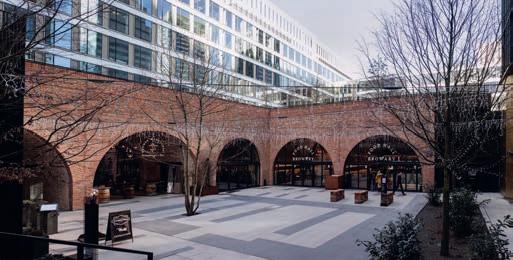
8 minute read
INSIDER'S GUIDE
For a catch-all solution offering a variety of food, drinks and social experiences under one address, check out the following Warsaw legends…
COMMUNITY HUBS & FOOD HALLS
Browary Warszawskie
ul. Grzybowska 60, browarywarszawskie.com.pl
BACK STORY
Established in 1846, the Haberbusch & Schiele brewery that once occupied this plot was the largest such plant in the entire Kingdom of Poland. Later also producing Coca Cola under American license, the complex later fell into complete dereliction. Opened last year after seven-years of work, the resulting Browary Warszawskie has utilized these surviving elements and set them against a swanky backdrop of freshly mapped streets and immaculate new build that feels contextually suited to the district.
F&B
Billing itself as a premium food hall, the centerpiece of Browary contrasts well against Warsaw’s other offers. Occupying a beautifully lit vaulted chamber that was once used to store beer, this magnificently formed space presents an offer based around a “quality over quantity” with twelve concepts vying for attention. Pertinently, the wider offer has also cemented itself into Warsaw’s conscience thanks to addresses such as Robert Lewandowski’s Nine’s sports bar, a flagship brewery-restaurant, the ever popular Balkan eatery Munja, and Baila – a stunning live entertainment hangout.
Good To Know
Warsaw’s first ‘woonerf’ has turned what could have been an ordinary, boring road into a living organism on which people and cyclists flow as one with the passing traffic. Lined with photographic exhibition panels, these have included an in-depth look at the area’s relationship with Coca Cola. And then, half-way in, you have one of the capital’s finest staircases –turned into a canvas, its steps have been used to create the city’s first ‘stair mural’.

What We Love
You can’t knock Browary’s ambition. More than just an entertainment hub, it feels more like a city within a city. Skillfully planned and deftly executed, you could survive here for a year and never feel bored. Moreover, there’s the underpinning mood: chic and affluent but equally easygoing. For that, it can’t be beat as meeting spot.
Elektrownia Powi Le
ul. Dobra 42, elektrowniapowisle.com
Back Story
Initially completed in 1904 to serve as Warsaw’s primary source of electricity, Elektrownia appears with frequency in local history books – contested during the 1944 Warsaw Uprising (shrapnel holes still dent the building at intervals), it later powered the Palace of Culture – to this day, the switchboard survives. Deactivated in 2001, the vacated buildings briefly became the home of giant house martens and other mythical urban creatures, before being restored and relaunched in 2020. As smart as its new look is, you’re always touching distance from history.
F&B
Lit by a sea of neon, the food hall is a street food mecca with star turns provided by Philly’s Finest Cheesesteak and Uki Uki Kikuya. Bracketed either side by two flagship bars, the smoothness of this operation can’t be questioned. But this is all complemented by standalone restaurant project such as the chic and design-minded Dock 19 and legendary, fun-fuelled Blue Cactus.
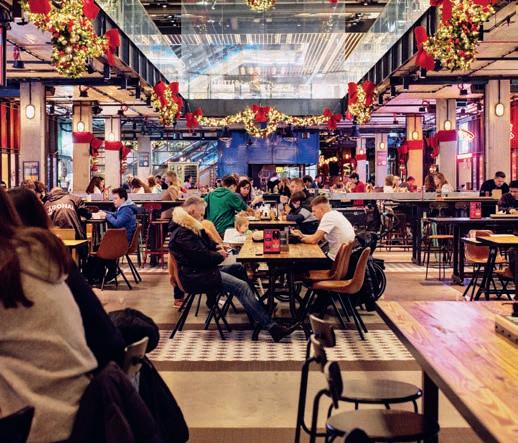
Good To Know
Elektrownia’s blended approach deserves to be called out. This includes an exclusive top floor beauty hall filled with cutting edge cosmetic and beauty therapy solutions – that Anna Lewandowska has been tagged here should speak for its pedigree. On the retail front, EP tends to avoid the mainstream to instead slant in on contemporary Polish design, upscale vintage, niche brands and established local talent. Watch, too, for their regular organic markets and ‘slow’ design fairs.
Why We Love It
Everyone agrees, Elektrownia Powiśle is a breathtaking work. From the outside, it’s a dazzle of billiard green lawns and spurting water fountains, all hemmed in by smart redbrick buildings trimmed with steel and glass. But inside is where it really gets going – cavernous in its size, and criss-crossed with vertiginous walkways snaking overhead, it carries the dimensions and impact of a Romanesque cathedral. Historic leftovers abound (such as the blue cubbyhole once used by the plant’s director), as do whimsical pieces of art made from rescued girders. Ingeniously connecting the past with the present, exploring its many corners is fun in itself.

Hala Gwardii
Pl. Mirowska 2, halagwardii.pl
Back Story
Built as a market hall during Tsarist times, in later years Gwardii became ‘the home of Polish boxing’ – in 1953, under the guidance of coach Feliks Stamm, Poland’s team triumphed over its Soviet and German counterparts to rack up a horde of nine medals at the European Boxing Championship. Resurrected as a food hall in 2017, its unpolished interiors have helped it retain a gritty authenticity and a lingering sense of history.
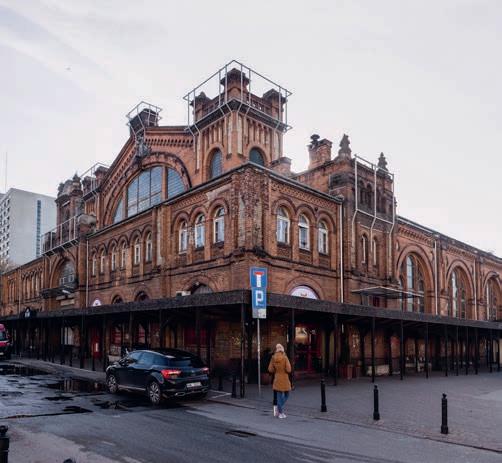
F&B
There’s two sides to Gwardii, almost literally. On one, find a farmers’ market whose gems include freshly baked goods, local jams and preserves, and fresh fruit and veg. Then, separated by a communal eating area, find a row of street food hawkers covering a span of global cuisines. Gluing it altogether is the social angle: don’t leave without an expertly poured Guinness from The Shamrock, craft beer from San Escobar or Piwna Gwardii or a cheeky glass of wine from the exceptional Niewinność.
Good To Know
Gwardii’s non-standard events have aided their mission to appeal to all: over the last year alone, that’s meant zero waste markets, boxing galas, dog fairs, poster sales, TEDx talks, ping pong tournaments, craft beer fests and a slew of national culinary days. Attracting young and old from all imaginable backgrounds and income brackets, these events have helped underscore Gwardii’s democratic nature: all are welcome, and all have some reason to visit.
Why We Love It
The lockdown was a make or break time for many in the F&B industry, but Gwardii seemed to emerge from the wreckage all the more stronger – at the peak of Covid, their market provided a glimpse of normalcy during paranoid times and acted to hold the community together. This feeling has continued. Uninten- tionally perhaps, the symbiotic relationship that it enjoys with the vastly contrasting Hala Mirowska next door has helped this – managing to harmoniously co-exist, these two entities feed off each other to add a diverse variety to the area’s social fabric.
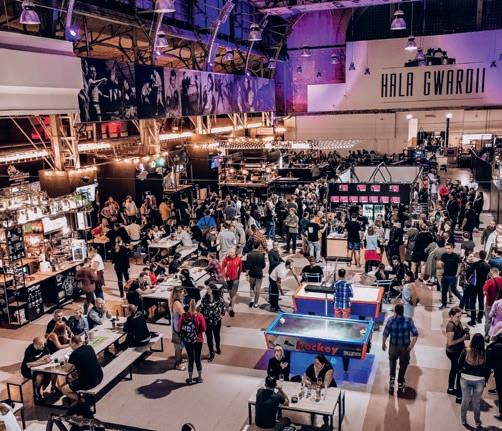
Centrum Praskie Koneser
Pl. Konesera, koneser.eu
Back Story
Built in 1897, from its early inception Koneser was built with one duty in mind: to produce vodka. According to one story, as German troops approached the city in 1915, the decision was taken to pour the vodka into the streets so as to prevent their soldiers getting their hands on it; apocryphal as it might be, the move reportedly sparked a riotous free-for-all among the disbelieving and grateful locals. Nationalized after WWII, Koneser only finished producing vodka in 2007; by that time, the plant was in dire need of care and attention and its Neo Gothic architectural details looked destined to rot and die. But not so. Subjected to a seven-year restoration process, it reopened in 2018 as a mixed-use project containing cultural sites, F&B outlets, swanky offices and loft-style apartments – no other investment has had a bigger impact on Praga’s overdue regeneration than Koneser.

Good To Know
Koneser could easily have become a self-segregated island of prosperity; instead, it’s been successfully absorbed into the neighborhood thanks, largely, to a busy program of events that have included slow fairs, ‘senior days’, food truck meets, book nights, concerts and history walks.
F&B
For foodies, the lynchpin that holds the food and drink offer together is Koneser Grill. Belonging to the portfolio of Ferment Group (owners and creators of Rozbrat 20, Butchery & Wine and a string of other essential eateries), enjoy a sophisticated, meat-centric menu amid smooth lighting, blond woods, metal fixtures and outbreaks of rich teal colors. Then, you’ve got the small matter of Bombaj Masala and its Indian street bites served in eclectic surrounds, and newbies such as Setki Powodów, a vibrant, fun space with on-tap cocktails, crazy shots and a menu devised by Insider favorite Michał Bryś (formerly our Chef of the Year).
Why We Love It
In a continuance of the above, it’s this cultural aspect of Koneser that has installed it as a Warsaw stalwart. In addition to the above one-off events, visit for the world class Polish Vodka Museum or the Museum of Fantastic Art. Last year’s Banksy exhibition remains one of the most talked about exhibitions in recent memory. Culture vultures can imbibe more domestic talent by heading to the likes of the Art Sułek Space (a gallery owned by the same artist behind Praga’s iconic blue angel statuettes).
Hala Koszyki
ul. Koszykowa 63, koszyki.com
Back Story
Built between 1906 and 1908, from the outset Koszyki was designed to serve as a market hall. Nationalized after WWII, by the 1960s it was attracting over 3,000 shoppers per day. By the millennium, though, business had slowed with shoppers favoring new generation supermarkets over the grubby old school style offered by Koszyki. Acquired by Griffin Real Estate in 2012, it was under their watch that the main hall was rebuilt and the art nouveau wings restored. Original plans foresaw a retail project taking root, but this was abandoned in favor of what we see now. Revolutionizing Warsaw’s food and drink scene, the 2016 reopening of Koszyki can be considered one of the watershed moments in the city’s gastro timeline.

F&B
Koszyki’s food hall checks all the boxes when it comes to comfort food; for burritos, you can’t go wrong ordering from the fist-bumping lads at Gringo, while for craft beer and grilled sausages then Kiełba w Gębie don’t put a foot wrong. The biggest lines, though, they’re usually reserved for Soul Food Burgers. But there’s more to Koszyki than just its food hall; for fancy modern Polish food in arty surrounds then Warszawski Sen is a winner. More often than not though, you’ll find us either propping up the Central Bar, sipping cocktails in The Upper Deck, or putting the finishing touches to a night out in the open-all-hours ĆMA
Good To Know
Koszyki have a hard-earned reputation for higher brow events such as classical recitals and author meet and greets. However, not all of their attractions are quite so traditional –2022 saw them dishing up a VR film about the Warsaw Uprising.
Why We Love It
Opened in 2016, Hala Koszyki was the first of the hubs to launch and blazed the trail for others to follow. Considered the grande dame of all, this reputation can be credited to more than just her age. To this day Koszyki remains a pioneer and often the default choice when planning a city center meet-up. Why? It’s vibe and central location are second-to-none. Where the former is concerned, the outdoor plaza remains one of Warsaw’s favorite summer check-ins while in other months the spectacular wrought iron interiors always have a buzz.

NORBLIN
Factory
ul. Żelazna 51/53, fabrykanorblina.pl
BACK STORY
Opened on the site of a former metal factory, the scale of Norblin takes a while to sink in. A beautiful combination of new and old, it’s a photogenic example of everything that makes modern Warsaw so captivating.
Representing 200-years of history, the two hectare site is riddled with over 50 leftovers from the Industrial Revolution.
F&B
Warsaw’s largest food hall has been intelligently designed so as to retain intimacy while never ceasing to remind visitors as to its diverse range of choices – the so-called ‘Asian district’ scores particularly highly. In standalone terms, top marks go to the elegant Piano Bar, the eclectic Uwaga craft beer haven, and the Tex Mex kings at Blue Cactus. Finally, check into the Bio Bazar, a farmers’ market with a reputation that extends nationwide.

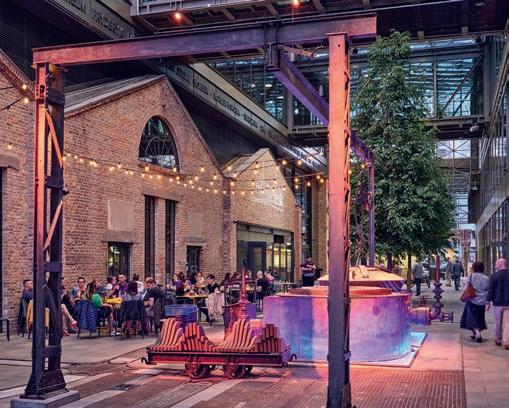
Good To Know
Remember when a kids zone meant little more than some tatty coloring books and board games with missing pieces? At Norblin, welcome to the future: functioning under the name of Smart Kids Planet, kids have nine areas to explore over a floorplan of 1,600 sq/m. Featuring themes such as the ‘smart shopping zone’, ‘apple orchard’, and ‘discovery zone’, these have been tailored to promote logical thinking, healthy eating, motor functions, perception and creative thinking.
Why We Love It
The lengths Norblin have gone to differentiate themselves have been extraordinary: for examples, refer to the luxury Kinogram cinema (Champagne vending machines, for Pete’s sake!) or the Art Box Experience – an immersive multimedia space that stole our hearts earlier in the year with their look at retro Warsaw. Then, you’ve got the only Apple Museum in the country (as in the tech brand, not the fruit). Mindful of their own heritage, the launch of a factory museum and guided walks (conducted by app or in person) can be cited as further proof of this project’s appreciation of local history.










